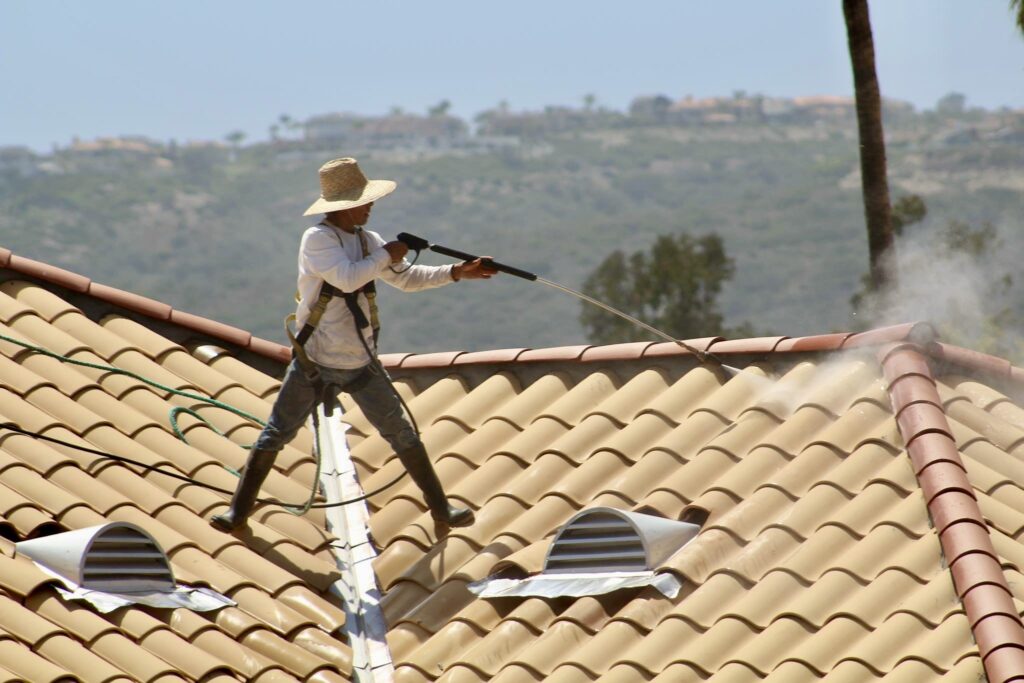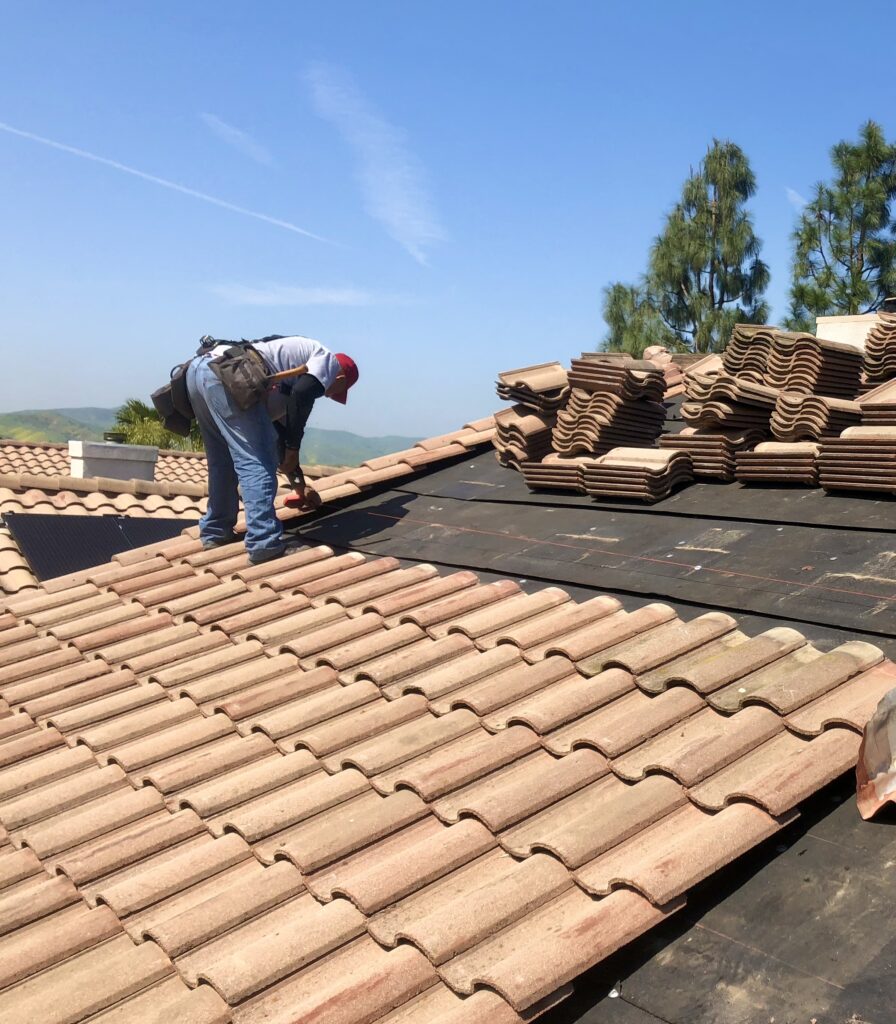Now that you are considering RPainter as your exterior painting experts, we have prepared for you a list of the most frequently asked questions and concerns we receive regarding the our procedure. Have questions that are not on the list? Send us a message!
How much does the Roof Tile Restoration cost?
Typically no more than 1/3 the cost of re-roofing.
How long does the job take from start to completion?
Typically 1 to 2 days unless there are unusual circumstances.(Ex. Extensive termite – dry rot replacement etc.).
Before this very important question can be answered we believe you should first know what options are available. We will attempt to clarify what these options are, ultimately the final decision is yours; we hope that knowing what your options are will assist you in making the right decision.
Since the condition of the roofing felt is the primary concern we thought it would be helpful in identifying what roofing felt is it made of, what function it serves, and what happens to it over a long period of time.
The type of felt typically used in roofing called Asphalt Saturated Felt. It is manufactured by taking natural organic fibers which are turned into a dry paper mat; this mat is then saturated by a high grade of oxidized asphalt to provide water resistance and dimensional stability. Felt primarily functions as a vapor bather and in a tile roof system as a secondary water shedding barrier in the event that water gets behind the tile. It is the nature of felt to break down once the oils in the felt have dried up due to long term exposure to nature’s elements. It is important to note that even though the felt paper may be dried up that does not mean the roof is no longer waterproof.
Option #1: Tile Restoration
First an on-site visual inspection will be done of the tile roof to determine its current. Condition and to address any areas of concerns. With over 35 years of combined roofing experience our first objective is to make sure the tile roof will keep water out.
Over the years it has been our experience that leaks on tile roofs that were installed properly are typically the result of: Wind driven rain entering thru the weather-blocking at hip or ridge section due to a crack or break down in and Waterproofing at these areas, broken tiles, debris from frees etc. creating damming effects in roof valley areas Sealants cracked around roof flashings due to long term exposure to the weather and UV sun rays. All these Conditions can be repaired and a general maintenance will be performed to the roof prior to the start of our Tile Restoration Procedure.
Cost: Typically we can repair, perform a general maintenance and restore; (make your old tile roof look like new for about 1/3 the cost of buying a new roof)

Option #2: Felt Underlayment Replacement
This procedure would involve the lifting up and/or removal of all existing tile depending on the slope and layout of the roof. Typically one or more layers of new felt would be installed over the existing felt unless other arrangements have been made. Re-installation of the existing tile would then take place. If this is a procedure you are considering, we would recommend all new flashing and perimeter edge metal.
Costs: This is labor intensive procedure and therefore very expensive; costs could easily run $ 2.25 to $2.50 per sq. ft. which is more than 2X the costs of tile restoration. (Keep in mind that once you have spent all that money you will still have a roof that looks old)

Option #3: Buying a New Roof
Cost of a new tile roof is usually 3 to 4 times as much as you would have paid to have your old tile roof restored. You may also be replacing a roof system that may not have any leaks or at least a minimum amount that could have easily repaired. However, re-roofing is a valid option especially if you are planning a major design change or you are tired of the existing one.
What is concrete tile made of?
The main raw materials used in the manufacturing of concrete tile are: cement, fly ash, sand, aggregates and water.
How long does concrete tile last?
Concrete tile lasts indefinitely as long as it is properly maintained, cleaned and broken tiles replaced. The tile actually gets harder with age.
Why does my concrete tile look dull and faded?
When concrete tile is subjected to long term exposure from nature’s elements (sun, rain, wind) some tiles will begin to lighten or fade from their original color. These effects occur primarily as a result of oxidation on the tile surface.
What are the yellow-green and sometimes black looking substances on my roof?
Algae and Moss.
Many tiles have rough surfaces by design or as the result of long term exposure to the forces of nature and the environment; dirt, pollutants and moisture attaches themselves to this surface and algae and moss growth occurs.
Algae and moss can be removed by high pressure water system, (keep in mind that even though your tile may clean up nicely, without a sealer and/or coating with a biocide included, algae/moss will re-appear on your tile quickly.)
Why do homes near the coastal areas and some inland areas have more algae and moss on them?
Roofs near the coast and foothills are going to be exposed to a lot more moisture from the ocean and dew. North facing roofs will exhibit the most algae because the they receive less sun, which does not allow for the moisture on those north facing roofs to dry adequately.
What effect do vehicle emissions have on my tile roof?
Vehicle emissions produce Sulfur and Nitrogen Oxide which combine with water vapor (over night dew) to produce Sulphuric and Nitric Acid (Acid Dust) which settles on the concrete tile’s surface and begins to deteriorate the Concrete surface.
How does Tile Magic clean tile roofs?
We Hydra-Wash the roof using high pressure water only, we do not use any chemicals.
The predominant substances that are going to come off the roof is what nature and the environment put there to begin with. This would include: Algae, Dirt, Pollution, Sediments and Organic Oxides.
What will happen if I have my tile roof cleaned but not sealed or coated?
By pressure washing your concrete tile roof, you will not only remove the dirt, you will be exposing the pores of the tile, which will enable the surface of the tile to easily absorb moisture and create an ideal situation for algae/moss to come back faster.
Yes, however, we do not recommend it unless it is done by experienced roofing professional. There is a proper way that roof tile should be walked on to keep from breaking or at least keep breakage down to a minimum. (It also helps if you weigh less than 200 pounds).
I have roof leaks and some broken tiles; what can be done?
With over 35 years of combined roofing experience we can identify and repair any tile leak or roof problem.
I have termite and dry rot damage on my fascia boards, rafter tails and shiplap, what can be done?
For an additional cost we will replace these boards, prior to performing our tile restoration procedure.
Do tile roofs require maintenance; if so, how often?
Tile roofs do require a minimum amount of service for any number or reasons especially if you have trees and foliage at or near the roof line. Pine needles as well as other debris that accumulates on the roof will create a damming effect in valley sections once moisture is introduced via rain or dew. Some sealants around pipes (roof penetrations) will crack due to movement between the structure and foundation as well as long term UV exposure from the Sun. Broken tiles as a result of foot traffic 🙁 Painters, Plumbers etc.) And objects being thrown on the roof
(We recommend an annual inspection of roof before the rains start) as a part of our restoration procedure we first replace any broken tile and inspect all roof penetrations and re-seal them with High-grade sealants. Many roofers would charge several 100’s of dollars for this service alone; we include this service when we restore your tile roof
My tile roof is only 12 years old, can I just have it cleaned up or do I need to have it restored.
In our experience we have found that concrete tile roofs that are 12 yrs. or less clean up quite well and will require only a clear sealer. Note: The best way to determine what course of action to take is for us to clean up a small section of the roof and allow you the opportunity to decide for yourself.
How long does the roof coating last?
Depending on the type of coating application, environment and geographic location of the roof, our coating can last from 10 to 20+ years.
We offer a 10 year limited transferable warranty against; peeling, chipping or cracking.
How many colors are available?
Colors can be selected from our main menu consisting of 16 basic colors or we can create 100’s of custom color options to match an existing color or create a new color of your choice.
No problem, we can mix and match colors to accommodate most any color scheme you have.
